David Steinberg’s New York Times crossword—Amy’s write-up
David’s stretched the grid to 16 squares wide to accommodate two pairs of stacked 16s: EMPEROR PALPATINE from those non-classic Star Wars movies (or maybe just one of the movies?) with BATTLE OF THE SEXES, and “I HEAR YOU KNOCKING” (a song I’d never heard of) with COMPOUND SENTENCE. Here’s the original 1955 hit sung by Smiley Lewis; subsequent (and less bluesy) covers have also had some success.
The PETTY TYRANT, BOILERMAKER, CATNAPS, PFIZER, and BARBUDA (it’s married to Antigua) appealed to me.
Worst fill: A-TAT, WOOER, EELY, MAIN ST., NER, OATEN, ERLE. Only the last of these even crossed a stack! All those 7s and the 11s crossing the stacks caused trouble.
Clues of note:
- 25a. [Wheel that runs?], BRIE. Not sure I will ever eat Brie cheese again …
- 51a. [Raiser of horses?], TURBO. As in “thing that juices up the horsepower in your car.” Not that we ever use “raiser” for anything other than the Hellraiser movies. One of those weird crossword-clue words nobody uses. (Bonus points for crossing TYRONE Power and TURBO power!)
- 11d. [Holder of spirits], CASK. As above, we have candle holders but not “liquor holders” in the language. Cask ale is definitely a thing, but I’m not sure if it’s primarily a British or European thing.
- 12d. [Literally, “land of the sun”], UTE. Not a Star Wars fan? You may have had trouble getting the T here. Not your standard UTE clue.
- 52d. [Twice quattuor], OCTO. You’d think I’d have actually encountered the Latin term for “four” before, but no.
I am really not even sure what to say about 35d. [Vernacular much debated in the 1990s], EBONICS. I looked up some interviews with linguist John McWhorter (who’s African American) and see that he’s used the term a bit, but mostly goes with “black English” and notes that the linguists’ term “African American Vernacular English” hasn’t broken out into the mainstream. Can’t help feeling that the people who use “Ebonics” are usually using it in a pejorative sense and wrongly believe that AAVE is “ungrammatical” and “wrong,” when actually it’s got a very specific grammar and usage (such as using “be” for the habitual present tense in a way that standard English has no handy way to express). AAVE is really pretty cool, a dialect of English spoken by millions, and it would be great if folks would stop calling it Ebonics.
3.9 stars from me. I was going to knock it down a bit more for the blah fill in there (and the EBONICS jolt), but I enjoyed listening to the Smiley Lewis song and wouldn’t have known it without the puzzle.
Holden Baker’s Chronicle of Higher Education crossword, “All in Favor” — pronnonica’s write-up
Novel parsing of words possessing the prefix pro–. All share etymologies between old and new versions, but the divergences are significant.
- 17a. [Like Jeane Dixon?] PROVISION.
- 36a. [Like Hermann Rorschach?] PROTEST.
- 57a. [Like John Deere?] PROTRACTOR.
- 11d. [Like Edward Teller?] PROFUSION.
- 32d. [Like Joseph Pulitzer?] PROSCRIBE.
The consistent format of the clues—tersely invoking a representative person—strengthens the theme.
PARTISAN, stacked above one of the theme answers, seems affiliated with the theme itself. 55a [Not neutral]
- 16a [Adjective for many Oscar Wilde lines] ARCH. 51a [Coventry coolers] GAOLS.
- 15a [Onetime Pawnee neighbors] OTOES. Oh noes!
- 39a [Georg with a physics law] OHM, 42a [Exeunt ___ (stage direction)] OMNES.
- 1d [Wolf-pack leader] ALPHA, but I weirdly tried AKELA first.
- 7d [“The Muppet Show” sax player] ZOOT. See also ZOOT Sims, ZOOT Horn Rollo, and of course, ZOOT suits and the ZOOT Suit Riots.
- 45d [Swiss river seen from the Gelmerbahn funicular] AAR. Near BERN(E), natch. Tried to find a good video of the journey, but they were all rather amateurish. All right, there was one that was decent, but someone needs to do a high quality Norwegian Slow TV-style film of it.
- Favorite clue: 35a [Class that needs dummies] CPR. Runner-up: 10a [Reviewers of books, briefly] CPAS, even if it isn’t all that exciting.
- 33a [“__ by the Ocean” (platinum single of 2016)] CAKE. Obviously laying the groundwork for future inclusion of DNCE as crossword fill.
- 45a [“Now he belongs to the __”] AGES.
- 28d [Need a massage, maybe] ACHE.
And now this write-up belongs to the
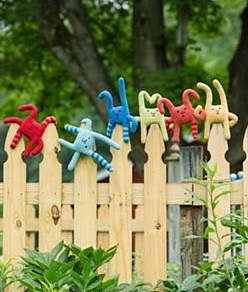
Lynn Lempel’s CrosSynergy/Washington Post crossword, “E-Tail” —Ade’s write-up
Good morning, everybody! How are those weekend plans shaping up? Today’s crossword puzzle, brought to us by Ms. Lynn Lempel, is more fun with puns, as common phrases are altered by adding an “E” to the end of the first word of the phrase, with those first words also referring to a famous person.
- WOLFE PACK (17A: [Tom’s kit bag?]) – Wolf pack.
- LOWE BID (37A: [Rob’s eBay offer?]) – Low bid.
- WILDE CARD (58A: [Oscar’s poker draw?]) – Wild card.
- GREENE PARTY (11D: [Graham’s gala gathering?]) – Green Party.
- PAINE REFIEF (24D: [Thomas’s deliverance from distress?]) – Pain relief.
Finally finished a grid in under 10 minutes for the first time in a couple of days, and I probably have to attribute that to finally being settled down at home while doing it. In a way, two great New York Yankees are being honored in the grid; GEHRIG (44A: [Yankee whose streak of consecutive games played was broken only by Ripken]) is a pretty obvious one, while HOLY COW was the signature catchphrase of Hall of Famer and longtime Yankees broadcaster Phil Rizzuto (45D: [“Oh my gosh!”]). Another intersection in the grid that I liked was DOPES (5D: [Blockheads]) crossing INEPT (20A: [Hardly competent]). Speaking of great location of fill in a grid, to the left of “Paine relief” was ACHE (55D: [What an Aleve might alleviate]) and the to the right of that was AILMENT (42D: [Complaint for the doctor]). Pretty slick! Can’t say that I’ve seen/heard SOCK IN anytime in the past few years (33D: [Cause immobility, as from bad weather]). Well, that streak is over, obviously!
“Sports will make you smarter” moment of the day: DWIGHT (31D: [One of Franklin’s generals]) – Despite being 5’8″, former National Football League wide receiver Tim DWIGHT carved out a 10-year career in the league as a wide receiver and kick returner. Dwight was a two-time All-American at the University of Iowa as a kick return specialist, and he continued to be one of the best kick returners during his time in the NFL. Probably his career highlight came in Super Bowl XXXIII, when he returned a kickoff 94 yards for a touchdown for the Atlanta Falcons in their loss to the Denver Broncos.
Thank you for the time, and have yourself a great weekend! See you tomorrow.
Take care!
Ade/AOK
Mike Buckley’s LA Times crossword – Gareth’s write-up
This theme type is one, like clue / answer reversal, that I find has far more negatives than positives. Here, all the answers on the edges are completed by HOUSE. The words’ clues require you to mentally insert HOUSE for them to make sense. A nice touch was the central symmetrical nature of the revealing HOUSE/BOUND.
The two biggest downsides to this theme are: 1. All short theme entries, which tend to make for a flat and repetitive theme. 2. The corners in particular are under considerable thematic stress, leading to above average fill compromise. The short theme answers are offset
by some nice longer answers, such as REDPLANET and ADHOMINEM. With regards to grid stress, UTILE/LUNAS and ROLLA/OILOF/LOIRE are found in two of the corners. The NW/SE pair are better contained. TOKORI is difficult, but interesting I think. Not a Michener novel I’ve read (and I’ve read quite a few!), but I think it’s about Korea?
Others:
- [Frequent flier’s respite], BIRD{HOUSE}. Clue of the puzzle!
- [Girlfriend of Garfield], ARLENE. Moderately familiar with the Garfield corpus – she feels like a character that appears rarely, but is used in a lot of merch and the like… Possibly like with Lyman there was a specific period when she featured frequently…
- [End of Louis], IANA. Ew.
3.25 Stars
Gareth
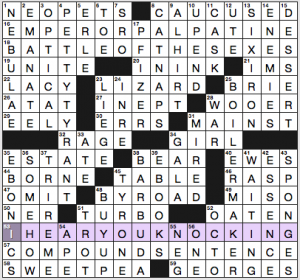
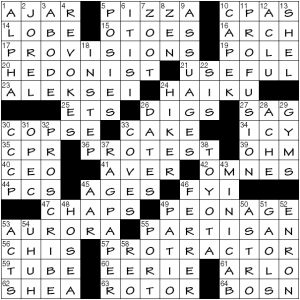
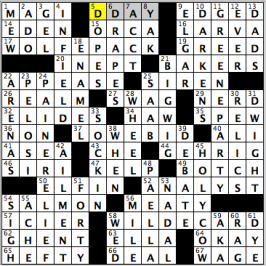
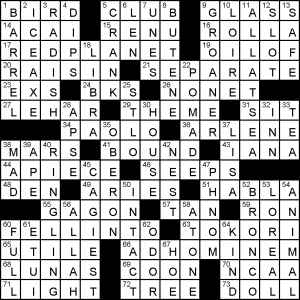
PSA: Apologies if this is out of place in this forum, but this tip may save someone else’s sanity, as it has mine. For die-hard ink-on-paper solvers without access to a printer and/or paper (it happens): don’t despair, use stylus-on-glass. How to with iPad Pro and Apple Pencil: open the puzzle image in PDF or Across Lite, take screen shot (simultaneous home button plus power button, which sends the image to your photos). Open Notability app, create new note, insert the image (“+” / media / Photo / all photos / (your puzzle image is most recent)). Resize. Choose your ink color & nib size with the pencil icon. Solve in your own handwriting. Ignore the erase option! Pinch/open to enlarge and enter rebus legibly. Take another screen shot to share. Improvise if you have another tablet/stylus. Now you can solve PDF’s on your tablet. You’re welcome.
Rated CHE 3 stars instead of the intended 4.5. Thanks.
The crossing of ner and trireme was a Natick for me. Otherwise I thought it was a great puzzle.
Given that everyone is expected to know their APSE from their NAVE, I’m pretty ok with a Friday puzzle including this object which is in every synagogue.
Fair point, Dave.
I’m not sure how “fair” that really is, given that less than 3% of the US population is Jewish and more than 60% is Christian. I’d say it was more esoteric than fair. Perhaps the Friday-puzzle rationale makes it fair but, still, not presumed knowledge by the general public. If it were to become common knowledge among Cruciverbalists, it might be considered crosswordese.
I wonder what percentage of religion-related crossword clues and answers are about Christianity. There’s a good chance it’s far more than “more than 60%.”
I wonder what percentage of music clues and answers relate to opera, vs. the percentage of Americans who listen to opera.
Considering that Jewish months ELUL, ADAR, and NISAN as well as Passover meal SEDER are very common crosswordese, NER isn’t so bad except that, like everything else I mentioned, it is a transliteration. I have seen it spelled NIR as well.
I think there’s more than 3% of Jewish terms used, too — if not Jewish, than Yiddish.
I’m just saying.
Unlike you, Amy, I don’t expect crossword puzzles to be an accurate, representational cross-section of the population. In fact, from their inception, I think they were geared to very specific audience of the well-read, well educated cosmopolitan. So, the question is not what percentage of the population listen to opera but, rather, what percentage of Cruciverbalists do. Of course, since the Shortz Era and the TV Guide fare, crosswords have expanded into other facets of the population, in an attempt to broaden its market, not necessarily to improve the puzzles.
Papa John, the problem is that even many educated, cosmopolitan, well-read people find the NYT crossword inaccessible because of vocabulary they’d only know if they’d already done lots of crosswords. I think it’s horribly elitist to expect crosswords to continue to repel newer solvers. I think puzzles are improved when they speak to more people. When more people find their realities reflected in the puzzle. When people aren’t made to feel dumb because they don’t know the word TRIREME or ERNE (words that the vast majority of bright, educated people probably do not know, unless they learned them from crosswords).
You’ve mistaken what I wrote to be judgmental when I was merely being factual. I didn’t offer an opinion as to whether or not contemporary puzzles have actually “improved”, only that the rationale for making them less elitist and more populist was to increase their market. Shortz has said as much on many occasions.
Again, I feel the need to point out that I differ from many on this blog as to the value of crosswordese. Imma like it!
I agree with John. APSE, NAVE and NER are all crosswordese in my opinion, but the first two are used in crosswords many times more. Using junk words that crossword solvers know is better than using junk words that they don’t.
Sarah, I couldn’t disagree more. Just because the longtime solvers have memorized a bunch of junk vocabulary they rarely need elsewhere in their lives, it doesn’t mean it’s good to keep including it. Why on earth was NITA Naldi in a puzzle this week? In 50 years, Dr DRE may be an obscure old name from pop culture, but right now, it’s a name an awful lot of people know. NITA hasn’t been relevant or interesting in decades, and I’d like it gone.
I wasn’t suggesting that things like APSE are ideal. I was just saying it’s better than stuff like NER.
Why you think I felt NITA was a good answer, I don’t know. I didn’t even mention it.
Amy, your last comment makes a good case for NOT including words like NER and TRIREME.
I thought it was a poor cross of two obscure words, although as I say below it was not a problem for me because I knew TRIREME (not from crosswords but from learning about the Greeks and Romans in school long ago).
For what it’s worth, it seems like NER is more akin to churchy words like ‘reredos’ and ‘rood’ than relatively common ones like ‘nave’ and ‘apse.’
As someone who grew up largely unchurched, I have to say that NAVE and APSE have always struck me as words I rarely ever encounter outside of crosswords. ROOD, at least, I learned in a college class on Old English literature (“The Dream of the Rood”)—but I know it’s not an everyday word.
I never studied Old English Literature in college, so I have only encountered “ROOD” in a crossword puzzle. Because of that, I now am familiar with the word, and consider my education to have been thus enhanced.
I also grew up unchurched, but I learned about NAVE and APSE and many other church-related words in my art history classes in school.
“Papa John, the problem is that even many educated, cosmopolitan, well-read people find the NYT crossword inaccessible because of vocabulary they’d only know if they’d already done lots of crosswords.”
Good discussion, though hard to continue on this reply-response format of the blog. What I’ve always figured with most of these grids is that they are a reflection of general and specific culture of the area – therefore I notice most references fit an East Coast cultural bias (with a smattering of West Coast bias), which comes out in the geographical, cultural, and general items called for in the crosswords. For instance, opera and Broadway references, among other things that more commonly exist on the Eastern Seaboard. Not a surprise given that it’s the New York Times, but I wouldn’t be surprised if most of the constructors were from a similar place. More or less, national exposure needs to mean nationally-aware items, though it can be hard to tell in many instances.
“I wonder what percentage of religion-related crossword clues and answers are about Christianity.”
In the grids I’ve done it’s somewhere between 70-80% Jewish/Yiddish references, though probably 70% of those would be accessible to a Christian as well (CAIN, ABEL, etc).
“I have to say that NAVE and APSE have always struck me as words I rarely ever encounter outside of crosswords.”
Most of the “churched” wouldn’t be aware of these words or their meanings.
And as for NYT “inaccessibility”, usually I find most grids are about logical wordplay when you can get beyond a certain point, but the frustrating part is not being able to “break” into a grid entirely or get into a certain part of the grid for not having knowledge of certain things. In effect, while I do get many answers I really don’t “know”, I need a certain amount of “gimme” or I can’t solve a puzzle. That leads to either tossing the grid or letting Google solve it for me, which turns the whole thing into a bad time.
“Most of the “churched” wouldn’t be aware of these words or their meanings.”
I agree and find it interesting that those with a liberal education know more about churches than those who are “churched”.
I also agree that this has been a good discussion.
I’d like to aid that, like any discipline, crosswords solving has its own lexicon and it needs to be studied and learned in order to excel as a solver. We have a name for that list of words — crosswordese.
I was thinking on this a bit, and while realizing it would trend into another discussion, I wondered what kind of things in a grid makes it harder for me to solve in comparison to another.
The answer I actually came across is one more of language – either a confusing clue, where I have to Google something in the clue to understand it, or the constructor trying to be too cute with wordplay/deceit to be comprehensible (the debacle of last Sunday’s LAT being a great example). Or a phrase that I never heard before in my life (ALLATSEA in today’s LAT being a good example). Again, language use has a cultural component reflecting the background of the constructor, but harder to measure overall.
That said, crossword solving has its way to be more about mastering confusing language than any form of lexicon. The lexicon is easily relayed as Reynaldo’s own book illustrates, so it becomes about other things in order to be able to solve crossword puzzles well.
Overall, I have found I have special difficulties with the NYT grids over all the others I’ve attempted for some reason I can’t put my finger on. I don’t know if I haven’t gotten my mind around Shortz’s language choices or what it is…but it’s quite interesting that most of my difficulties center on that one. (I only mention this because of the whole “NYT crossword is inaccessible” quote.)
It definitely makes the puzzle hard (more than just challenging) when obscure entries cross each other. How many times have I been left with one empty square and no option other than to Google or guess?
My father in law used to gripe about that very loudly – “Margaret Farrar would NEVER have allowed that!”
There were way more awful crossings in pre-Shortz puzzles. It’s just that solvers learned the crosswordese that those editors were partial to. A quick (10-second) perusal of xwordinfo found a Maleska-constructed, Farrar-edited puzzle of May 30, 1957 with ENARE (a favorite pre-Shortzian entry that’s a Swedish word for a Finnish lake) crossing AGAG (“Biblical king”). ENARE appeared 109 times in pre-1993 puzzles. AGAG appeared 43 times. (WS used AGAG twice, but hasn’t allowed it since 1995.)
Some other popular pre-Shortz entries include INEE, ARAR, UNAL, ENNS, ATLE, ISER, IRADE, AMENT, AVAL, RAMI, TAA, STOSS, NEP, SAIC and SNY. All these were used at least 75 times before Shortz and never in his era.
My entire Boy Scout troop learned about Ner Tamid. It’s a little more obscure that “menorah” as a symbol of Judaism, but it’s certainly found in the wild.
I got it from saying to myself…”l’chad lik ner”
NYT: Good puzzle, but I feel that “Adams and Jefferson, e.g.”=ENEMIES isn’t accurate. They might have been on opposite sides of politics for many years, but they were allies in the push for American independence, and in later life they came to good terms and maintained a regular correspondence, often writing letters to each other debating political philosophy
yeah, i was hoping for FRENEMIES for that one
NYT: 6d [Prominent feature of a sloth] TOE. Not particularly. It’s the claws that are prominent; the (number of) toes may be morphologically and taxonomically diagnostic, but they’re not especially easy to see. despite their considerable length relative to other skeletal features.
On my puzzle printout, 35d EBONICS was clued as [Speech in a Spike Lee film] – much tougher than the clue mentioned in Amy’s review.
That clue for the print edition is also likely to raise more eyebrows.
A little tougher than a typical Friday for me, mainly because I had THEWAROFTHESEXES for a long time, and the Star Wars terms are not part of my vocabulary.
From what I recall of the EBONICS kerfuffle back in the 90s, the word was introduced by those who advocated for broader acceptance of AAVE and wanted a non-academic name for it. It didn’t really take hold, but I don’t see it all as a pejorative term — not in its original conception, at any rate.
OPTICAL — I would have preferred to see some qualification in the clue. Many microscopes and spectroscopes do not operate in the optical region.
NER — totally unknown to me, but TRIREME wasn’t a problem.
For a more complete grasp of EBONICS, I suggest a scan of the entries for it on Urban Dictionary. The word can’t seem to make up it’s mind about being pejorative or not. I agree, however, not in its original usage.
legit lol at this thinking that competing definitions on Urban Dictionary are the word disagreeing with itself, and not, like, actual people with agendas disagreeing over its meaning
Re EMPEROR PALPATINE: this is the same character as “the Emperor” who appears briefly in Empire Strikes Back and a lot in Return of the Jedi. “Palpatine” the name doesn’t show up in the movies themselves until the prequels but is was used extensively in novelizations, merchandising, etc for decades before that.
I personally had more trouble spelling EMPEROR correctly than PALPATINE :)
I don’t consider any of these clues/answers to be “religious” or anything else other than culturally aware. Although I was raised Jewish, I don’t follow the Hebrew calendar and what I know of it I learned from doing crossword puzzles. Same with the Greek alphabet. I do not attend church, but I know the difference between an “Apse” and a “Nave” because I studied Art History in school. I still struggle over rap and hip-hop references because I don’t follow that music at all – but I also struggle with Hollywood-related clues in general.
As I’ve said in earlier posts, I consider these puzzles to be primarily about wordplay, not about “fairness” or equal representation – and while one puzzle may lean heavily in one direction, another may lean in another. I don’t have any statistical evidence about the overall balance among all the puzzles I do, but I can say that I have never been offended by puzzles that stray far from my own cultural identity, and on the contrary, while frustrated often at having to Google some answers, I believe that in some small way doing these puzzles has increased my awareness of cultures, musical genres, sports & entertainment trivia and word usage.
As for “EBONICS”, well, the clue did say that it was “much debated”. My take on that is that this is a clue based on the history of the term, and that the debate may well have been simply about whether or not the term was pejorative or offensive. Within that context, I find it to be fair game
TRIREME was a gimme for me and I never really noticed NER. Lucky, I guess, as I had never heard it or seen it before.
I have seen all the Star Wars movies and still did not remember PALPATINE. I thought the T was the only logical crossing with U_E, but was not sure.
Very easy puzzle for me. I can never remember which is the APSE and which is the NAVE. TRANSEPT is the only one I usually remember.
As to the general issue of inclusion in a crossword puzzle, I like the NYT the way it is and that is why I do it. If it were more representative of the population at large, there would be far more sports references than there are, to name one underrepresented area. As a lifetime jock, I am happy when there is a sports reference (maybe that is the same type of desideratum of those who want to see more women and people of color), but I recognize that the crossword world has its own eclecticism.
Steve
About the Ner Tamid: I think what the constructor was trying to do by capitalizing Tamid was to keep the two words together as a phrase instead of just two words, one of which modifies the other. Ner Tamid is a “thing,” but ner and tamid are just two vocabulary words. The Ner Tamid is the eternal light that is hung over the place where the Torah is kept in the temple or synagogue. It isn’t just a ner, modified by the word tamid. It is the Ner Tamid, an object of symbolism. Hope that helps. Ask the constructor. That’s most likely what he had mind, in my view, but it might be difficult for non-Jews to parse.
Why are answers to the Friday WSJ puzzle not posted?
Contest puzzle?
Yep, look for my post to publish at midnight ET Sunday.
Yep, if it’s not completely decimated by spoilers before then (at the rate the comments over at WSJ are going).
Anyone interested in a learned discussion of AAVE might want to check out “Black English” by JL Dillard. I read it when it came out in the 70s and am not sure how far it has been surpassed by more recent scholarship. But I found it fascinating. It caused a stir by being the first study for the general reader to demonstrate that AAVE was a coherent language and not just an “incorrect” form of received American English.
I solve on paper so I, too was a little surprised at the cluing for “Ebonics.” Can someone enlighten me as to how it appeared online?
(It’s in Amy’s write-up.)